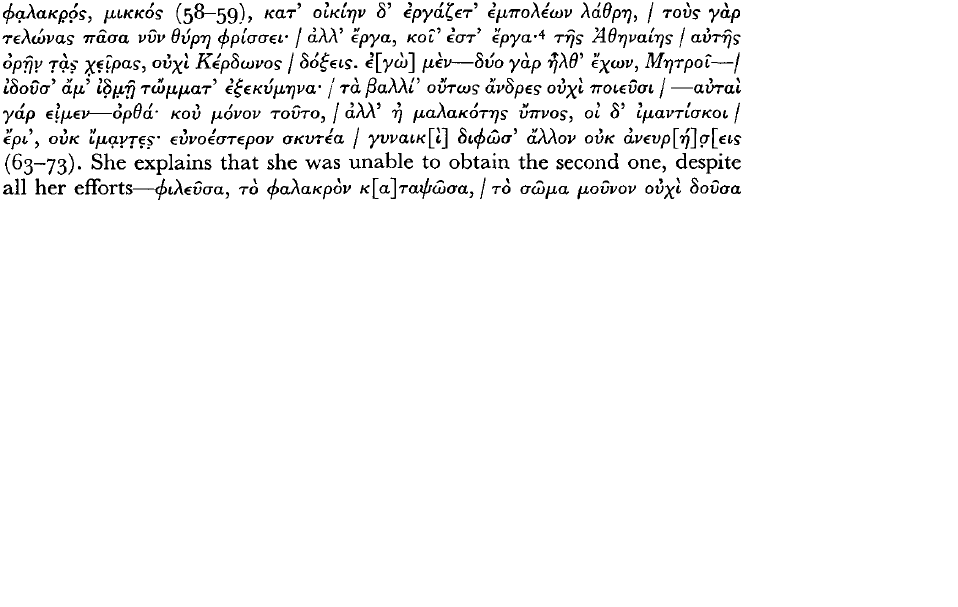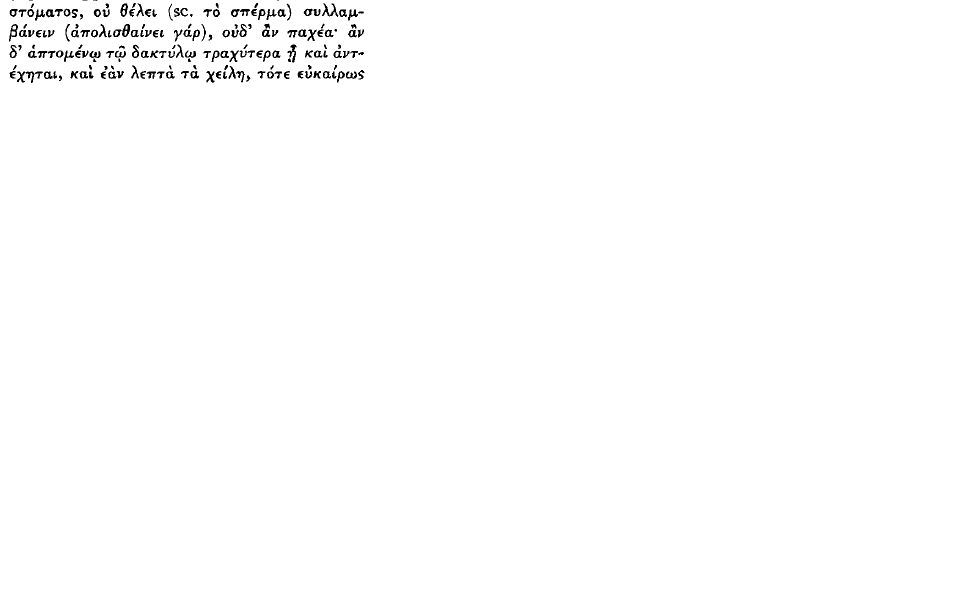Article contents
Herodas 6 and 7 1
Published online by Cambridge University Press: 11 February 2009
Extract
In the sixth mime of Herodas is described a visit by a woman called Metro to her friend Coritto. After an introduction ( I-I 7) largely taken up with abuse of Coritto's slave, Metro comes to the point: she asks, 
 (18–19). Coritto is furious that knowledge of this precious possession has spread so far, and without answering the question asks where Coritto saw it: the reply is,
(18–19). Coritto is furious that knowledge of this precious possession has spread so far, and without answering the question asks where Coritto saw it: the reply is,  (20–21). Coritto laments the faithlessness of those she thought her friends, but is consoled by Metro, who repeats her question. Coritto now reveals that the craftsman was Cerdon, and describes him and his works:
(20–21). Coritto laments the faithlessness of those she thought her friends, but is consoled by Metro, who repeats her question. Coritto now reveals that the craftsman was Cerdon, and describes him and his works: 

 and she was prevented from this last only by the presence of a neighbour's slave. Metro now asks how Coritto got to know Cerdon, and on hearing that it was through Artemeis, she declares her intention of going to see her, to learn more of Cerdon, and departs (95–98). The poem ends with Coritto giving orders for the door to be closed and the hens counted.
and she was prevented from this last only by the presence of a neighbour's slave. Metro now asks how Coritto got to know Cerdon, and on hearing that it was through Artemeis, she declares her intention of going to see her, to learn more of Cerdon, and departs (95–98). The poem ends with Coritto giving orders for the door to be closed and the hens counted.
- Type
- Research Article
- Information
- Copyright
- Copyright © The Classical Association 1964
References
page 32 note 2 I believe that the dialect employed by Herodas did not admit aspiration, and hence print no rough breathings. I hope to justify this in a later article, but in the meantime refer to Meister's edition (Abh. d. kgl. sächs. Ges. d. Wiss., phil.-hist. Kl. xiii. 7 [1893], 776 f.Google Scholar). In general I give Knox's text (Loeb, 1929); differences in the marking of doubtful letters are due to a re-examination of the facsimile.
page 32 note 3 Crusius's view (Unterstich. zu den Mimiamben des H. [Leipzig 1892], 118;Google ScholarPhilol. lxxix [1924], 377Google Scholar), that this is a malicious reference to the two poetesses Nossis and Erinna, who were probably contemporary with Herodas, is given added probability, as Prof. Lloyd-Jones notes, by the inclusion of  and
and  in the list of shoes (?) in 7. 57–58, Baucis being the addressee of Erinna's most famous poem.
in the list of shoes (?) in 7. 57–58, Baucis being the addressee of Erinna's most famous poem.
page 32 note 4  Herwerden, (B.ph. W. xi [1891], 1219)Google Scholar:
Herwerden, (B.ph. W. xi [1891], 1219)Google Scholar: 
 Headlam, olim (Athenaeum 1891, 354Google Scholar). The use of the indirect interrogative pronouns in exclamations in classical Greek is (despite Lagercrantz, O., ‘Zu den jriech. Ausrufesatzen’, Eran. xviii [1918], 33–36Google Scholar) uncertain (the date of Ps.-Theocr. 20. 6, not mentioned by Lagercrantz, is indeterminable, cf. Gow, , Theocr. ii. 364Google Scholar), but there is no doubt about that of the direct interrogative:
Headlam, olim (Athenaeum 1891, 354Google Scholar). The use of the indirect interrogative pronouns in exclamations in classical Greek is (despite Lagercrantz, O., ‘Zu den jriech. Ausrufesatzen’, Eran. xviii [1918], 33–36Google Scholar) uncertain (the date of Ps.-Theocr. 20. 6, not mentioned by Lagercrantz, is indeterminable, cf. Gow, , Theocr. ii. 364Google Scholar), but there is no doubt about that of the direct interrogative:  (Il. 1. 552, wrongly punctuated as a question by Allen and others), and see, after Lagercrantz, I.c. 27–30, Schwyzer, , Gr. Gr. ii. 626,Google Scholar and Lorimer, W. L., C.R. N.s. ii (1952), 94.Google Scholar Milne (ap. Knox) read
(Il. 1. 552, wrongly punctuated as a question by Allen and others), and see, after Lagercrantz, I.c. 27–30, Schwyzer, , Gr. Gr. ii. 626,Google Scholar and Lorimer, W. L., C.R. N.s. ii (1952), 94.Google Scholar Milne (ap. Knox) read  hence
hence  Cataudella, (Eroda, I Mimiambi, Milano, 1948Google Scholar) and Puccioni, (Herodae Mimiambi, Firenze, 1950)Google Scholar; but I think that
Cataudella, (Eroda, I Mimiambi, Milano, 1948Google Scholar) and Puccioni, (Herodae Mimiambi, Firenze, 1950)Google Scholar; but I think that  as was previously read, is better, and aphaeresis after a short vowel is hardly possible. Against Knox's text
as was previously read, is better, and aphaeresis after a short vowel is hardly possible. Against Knox's text  see Puccioni, , ‘Eroda vi. 65’Google Scholar, S.I.F.C. xxiv (1949). 231–3.Google Scholar
see Puccioni, , ‘Eroda vi. 65’Google Scholar, S.I.F.C. xxiv (1949). 231–3.Google Scholar
page 32 note 5 On the correct form of this name,  and not
and not  , see Schulze, W., ‘Zu Herodas’, Rh. M. xlviii (1893), 252–3Google Scholar = Kl. Schr. 418–19.Google Scholar
, see Schulze, W., ‘Zu Herodas’, Rh. M. xlviii (1893), 252–3Google Scholar = Kl. Schr. 418–19.Google Scholar
page 33 note 1 The propriety of using the expression ‘the same character’ might be doubted if it were maintained that, as Herodas works in the field of stock types and shoemakers are conventionally bald and called Cerdon, therefore the bald shoemaker Cerdon of 6 is neither the same man as nor a different man from the bald shoemaker Cerdon of 7. This raises an important point which is too far-reaching to be gone into here. However, the evidence that the bald shoemaker Cerdon is a stock type is not conclusive. Baldness appears to be a characteristic of low, cunning people, including shoemakers but not peculiar to them (cf. Hcadlam, p. 2): and Cerdon is normally a slave name, given to a shoemaker elsewhere only in Martial (3. 16, 5g, 99; all of the same person), and there is some truth in Headlam's point (p. xlix) that ‘the very conjunction sutor Cerdo in Martial [59: also sutorum regule, Cerdo in 16] shows that there may be no intimate connexion of the two names—one would have been enough’. The possibility cannot, however, be excluded that our evidence is defective. This would not affect my main point, but only the manner of presentation: one should then start from the identity of subject, and in view of this consider to what extent, if at all, Herodas thought of his characters as individuals, not as stock types.
page 33 note 2 R.É.G. xiii (1904), 285.Google Scholar Reinach had previously (R.É.G. iv [1891], 228)Google Scholar followed the general opinion.
page 33 note 3 Les Mimiambes d' Hérodas i-vi (Groningen 1922), p. 176. Unfortunately he delayed a full discussion till his commentary on 7, which has never appeared.Google Scholar
page 33 note 4 Hérondas, Mimes. Texte ttabli par J. A. Nairn et traduit par L. Laloy (Paris, 1928).Google Scholar
page 33 note 5 Op. cit.
page 33 note 6 Op. cit. 97.
page 33 note 7 This is even more true if the order of the poems goes back to the author. There is no evidence either for or against this.
page 33 note 8 The context here is badly mutilated, but a tanner would apparently be appropriate. If the traces to be seen in the facsimile-three letters after a are ink,  cannot be read:
cannot be read:  (Diels, , S.-B.Berl. 1892, p. 389Google Scholar) would be possible. That the
(Diels, , S.-B.Berl. 1892, p. 389Google Scholar) would be possible. That the  given by the papyrus in this and similar names is a mistake for
given by the papyrus in this and similar names is a mistake for  was shown by Schulze, I.c. 251–2 = Kl. Schr. 417–18.Google Scholar
was shown by Schulze, I.c. 251–2 = Kl. Schr. 417–18.Google Scholar
page 33 note 9 Herzog, in Crusius, O., Die Mimiamben des Her., 2. Aufl. (Leipzig, 1926), p. 27.Google Scholar
page 33 note 10 See his introduction, pp. l-lii.
page 34 note 1 Knox ap. Headlam p. lii n. thought little doubt was left because of his placing of a fragment ov to fill the gap in 105, which he restored as 
 Edmonds, , (C.Q. xix [1925], 136Google Scholar) rightly objected to
Edmonds, , (C.Q. xix [1925], 136Google Scholar) rightly objected to  (his own conjecture,
(his own conjecture,  is fanciful), and the papyrologist Lamacraft (in Knox's Loeb edition) reported that the placing of the fragment was in fact dubious (Knox there gives
is fanciful), and the papyrologist Lamacraft (in Knox's Loeb edition) reported that the placing of the fragment was in fact dubious (Knox there gives  as an alternative to
as an alternative to  ). This is too fragile a basis to build on. Incidentally one may note that the only palaeographically suitable addition pro posed at the beginning of the line is
). This is too fragile a basis to build on. Incidentally one may note that the only palaeographically suitable addition pro posed at the beginning of the line is 
 (Herwerden, Headlam, Palmer).
(Herwerden, Headlam, Palmer).
page 34 note 2 There are two baubons in 6, and also on vase-paintings (e.g. JJ.D.A.I. xliv [1929], 173, and cf. n. 5).Google Scholar
page 34 note 3 In his translation of Herodas (Paris, 1893)Google Scholar
page 34 note 4 C.R. N.s. ix (1959), 99.Google Scholar
page 34 note 5 Professor Dover reminds me of the Attic red-figure vase (Brit. Mus. E 815; full photograph in Licht, H., Sitlengesch. Griechenlands, iii. 201), which depicts a woman about to use one baubon in the normal manner and apparently about to place another in her mouth. This passage therefore may not be purely metaphorical.Google Scholar
page 34 note 6 Professor Dover suggests understanding ‘in this way each of you will be able to see (from what the others choose) to what extent (or ‘in what way’) women and dogs, etc' But if the  -form is correctly identified here,
-form is correctly identified here,  can hardly mean anything but ‘why’; in favour of this, though not decisive, is that elsewhere in Herodas, when
can hardly mean anything but ‘why’; in favour of this, though not decisive, is that elsewhere in Herodas, when  (accusative) is not die direct object (3. 42, 6. 74), it always means ‘why’ (1. 9, 6. 44, 6. 47, 7. 77).
(accusative) is not die direct object (3. 42, 6. 74), it always means ‘why’ (1. 9, 6. 44, 6. 47, 7. 77).
page 35 note 1 The slight uncertainties in the text do not matter in this context.
page 35 note 2 Headlam ad loc.
page 35 note 3 Crusius, , Untersuch. p. 145.Google Scholar
page 35 note 4 Herzog, (Ph. W. xlvi [1926], 198Google Scholar), who points out that Headlam is wrong in taking it of speech (his examples are of 
 ). Herzog is probably right in going further and seeing a reference to sexual intercourse; for such a use of
). Herzog is probably right in going further and seeing a reference to sexual intercourse; for such a use of  Professor Lloyd-Jones compares Arist. HA 583a16 sqq.
Professor Lloyd-Jones compares Arist. HA 583a16 sqq. 

 (misleadingly referred to the lips of the womb by LSJ s.v.
(misleadingly referred to the lips of the womb by LSJ s.v. 
 and ‘womb’ are not co-extensive, see the passages from Hippocrates in LSJ s.v.
and ‘womb’ are not co-extensive, see the passages from Hippocrates in LSJ s.v.  II 2).Google Scholar
II 2).Google Scholar
page 35 note 5 øpovoṽvτa does not, pace Headlam, require the article (cf. Soph. El. 697 

 , with Jebb's note: Goodwin, , Moods and Tenses, § 827;Google ScholarSchwyzer, , Gr. Gr. ii. 408Google Scholar), although, as
, with Jebb's note: Goodwin, , Moods and Tenses, § 827;Google ScholarSchwyzer, , Gr. Gr. ii. 408Google Scholar), although, as  is rather an odd phrase and a caesura would be desirable, it might be better to read
is rather an odd phrase and a caesura would be desirable, it might be better to read  with Hicks, (C.R. v [1891], 357Google Scholar) and Schulze, (B. ph. W. xv [1895],Google Scholar 9 = Kl. Schr. 681Google Scholar). I can see no sense in
with Hicks, (C.R. v [1891], 357Google Scholar) and Schulze, (B. ph. W. xv [1895],Google Scholar 9 = Kl. Schr. 681Google Scholar). I can see no sense in  (so divided first by Jackson, , C.R. v [1891], 360Google Scholar) could not mean ‘out of the heat’ (Headlam) or ‘sans haste’ (Knox), while
(so divided first by Jackson, , C.R. v [1891], 360Google Scholar) could not mean ‘out of the heat’ (Headlam) or ‘sans haste’ (Knox), while  suits very well.
suits very well.
page 35 note 6  defined by Hesych. [β 98] as
defined by Hesych. [β 98] as  and commonly used of a shepherd's cloak may perhaps be a name for, or an allusion to, the
and commonly used of a shepherd's cloak may perhaps be a name for, or an allusion to, the  which is further suggested by the colour of
which is further suggested by the colour of  “lobster-shoes”. Headlam ad loc.
“lobster-shoes”. Headlam ad loc.
page 35 note 7 I refrain from adding to the extensive literature on the exact values of these prices. It is enough that they are very high.
- 1
- Cited by




